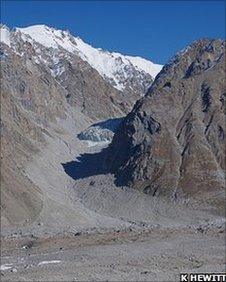Himalayan climate impacts 'cannot be generalised'
- Published

Mountain glaciers provide vital lifeblood for some of Asia's major rivers
Melting glaciers in the Himalayas will have varying impacts on the region's five major river basins, a study says.
Changes to the flow of meltwater as a result of global warming is likely to have a "severe" impact on food security in some areas, say scientists.
Yet people living elsewhere are likely to see food productivity increase, they added in a paper published in Science.
Overall, the food security of 4.5% of 1.4bn people in the region is threatened, the researchers conclude.
More than 1.4bn people depend on water from the Indus, Ganges, Brahmaputra, Yangtze and Yellow rivers.
"We show that meltwater is extremely important in the Indus basin and important for the Brahmanputra basin, but only plays a modest role for the Ganges, Yangtze and Yellow rivers," the team from the Netherlands wrote.
"The Brahmaputra and Indus basins are most susceptible to reductions of flow, threatening the food security of an estimated 60m people."
The researchers described mountains as the "water towers of the world".
"Snow and glacial melt are important hydrological processes... and changes in temperature and precipitation are expected to seriously affect the melt characteristics," they explained.
Summer rains
The team used data to assess a number of factors to reach their conclusions, including: the current importance of meltwater in overall river basin hydrology; observed cyrospheric changes; and the effects of climate change on the water supply from the upstream basins and on food security.
"The Yellow River, in particular, shows a consistent increase in early spring discharge, " they said.
"This is highly beneficial because most reservoirs are empty at the beginning of the growing season.
"An accelerated melt peak may thus alleviate a shortage of irrigation water in the drought-prone early stages of the growing season."
However, despite the projected compensating effects of increased rainfall in the Indus and Brahmaputra basins, the team predicted that summer and late spring discharges would eventually be reduced "consistently and considerably by 2046 to 2065 after a period with increase flows as a result of accelerated glacial melt".
"These anticipated changes will also have considerable effects on food security," they warned.
"By relating changes in upstream water availability to net irrigation requirements, observed crop yields, calorific value of the crops and required human energy consumption, one can estimate the change in the number of people that can be fed."
The team estimates that about 34.5m fewer people could be fed in the Brahmaputra basin; 26.3m fewer in the Indus basin; 7.1m in the Yangtze region and about 2.1m fewer around the Ganges.
However, they suggested that the changes could see an increase in food production in the Yellow River basin, enough to feed a further 3m people.
"In total, we estimate that the food security of 4.5% of the total population will be threatened as a result of reduced water availability," they concluded.
"The strong need for prioritising adaptation options and further increasing water productivity is therefore ever more eminent.
"We conclude that Asia's water towers are threatened by climate change, but the effects of climate change on water availability and food security in Asia differ substantially among basins and cannot be generalised.
"The effects in the Indus and Brahmaputra basins are likely to be severe owing to the large population and the high dependence on irrigated land and meltwater.
"In the Yellow River, climate change may even yield a positive benefit as the dependence on meltwater is low and a projected increased upstream precipitation, when retained in reservoirs, would enhance water availability for irrigated agriculture and food security."